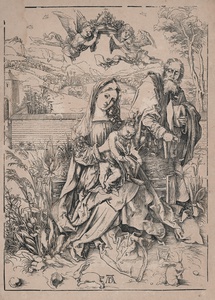| Method | Woodcut |
| Artist | Albrecht Dürer |
| Published | c.1497-8 [after 1600 impression] |
| Dimensions | Image 390 x 280 mm, Sheet 520 x 350 mm |
| Notes |
One of Dürer's earliest large-scale woodcuts, depicting the Holy Family in a walled garden. This is the first of Durer's woodcuts to focus on the Madonna and Child, a subject that he returned to many times, particularly in etching. The Virgin, seated on a hayrick at centre and gazing serenely out at the viewer, holds the infant Christ in her lap. She wears a heavy robe, with her long curled hair mostly covered by a long veil. The child, naked but for a necklace from which hangs a coral teether, is occupied in rifling the pages of a book of scripture. To their left, Saint Joseph looks on, while a pair of angels hold aloft a crown, signifying Mary as Queen of Heaven. Symbols of Mary's chastity are dotted throughout the scene, from the cloistered setting of the walled garden to the three hares that gambol prominently at her feet. The hare as a symbol of chastity, fertility, and virgin birth is an old one, dating back to Celtic and Germanic pre-Christian beliefs that hares were capable of parthenogenesis. As well as appealing to artistic symmetry and arithmancy, the three hares also stand as a reference to the Trinity. Beyond the safety of the garden's boundary walls, a mountainous landscape is shown, with a small village perched on the foothills by the banks of a wooded lake. Albrecht Dürer (1471 - 1528) was a celebrated German polymath. Though primarily a painter, printmaker and graphic artist, he was also a writer, mathematician and theoretician. Born in Nuremberg, Dürer was apprenticed to the painter Michel Wolgemut whose workshop produced woodcut illustrations for major books and publications. He travelled widely between the years of 1492 and 1494, and is known to have visited Martin Schongauer, the leading German painter and engraver at the time, at his studio in Colmar. In 1495, Dürer set up his own workshop in his native Nuremberg, and, by the beginning of the sixteenth-century, had already published three of his most famous series' of woodcuts: The Apocalypse, The Large Passion, and The Life of the Virgin. Nuremberg was something of a hub for Humanism at this time, and Dürer was privy to the teachings of Philipp Melanchthon, Willibald Pirkheimer and Desiderius Erasmus. The latter went so far as to call Dürer 'the Apelles of black lines', a reference to the most famous ancient Greek artist. Though Dürer's approach to Protestantism was not as staunch as that of his fraternity, his artwork was just as revolutionary. For their technical virtuosity, intellectual scope, and psychological depth, Dürer's works were unmatched by earlier printed work, and, arguably, have yet to be equalled. Hollstein 212, Meder 212 i (of i) Condition: Printed on laid paper. Very worn block. Dirt build-up and foxing to sheet, particularly to margins. Pressed horizontal crease to sheet. Chips, creases, and folds to margins. |
| Framing | unmounted |
| Price | £1,800.00 |
| Stock ID | 52269 |

